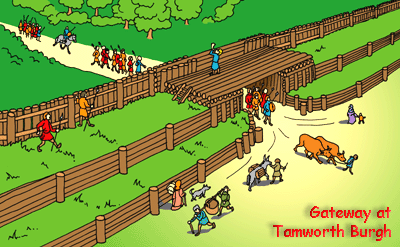|

|
|

King Alfred's
Walled Towns
 In the 9th Century, the Vikings
tried to take over England. They invaded Wessex and
Mercia. There was
a bloody war but, eventually, the Saxon King Alfred won. The Vikings
went home. In the 9th Century, the Vikings
tried to take over England. They invaded Wessex and
Mercia. There was
a bloody war but, eventually, the Saxon King Alfred won. The Vikings
went home.- Alfred wanted his people to be
safe from Viking attacks. So he set up 'Burghs' all over Wessex.
- The word 'Burgh' is the same as
'Bury' or 'Borough'. It means a defended place. It still exists in
placenames like Edinburgh.
- Alfred's Burghs were forts with
strong defences. People from the countryside could run to safety
inside them when the Vikings attacked.
- Some were built inside old hillforts,
like Chisbury (in Wiltshire).
- Some were built in old
Romano-British towns, like Winchester (in Hampshire).
- Some were built around villages, like Wareham (in Dorset). They were often at
river-crossings.
- Some were built on islands,
like Sashes Island at Cookham (in Berkshire).
- The King's men built big banks
and dug deep ditches all around the burghs. They put strong wooden
walls on top of the banks.
- The Burghs had a permanent
garrison (a group of soldiers who defended a single place).
- Some burghs had grids of streets
laid out and they became busy towns. There would have been lots of
industry (making things) going on, like dyeing cloth and grinding corn
(to make bread).
- Some burghs were quite empty
inside. This meant there was plenty of room for people when they had
to run and hide there.
- The King used them as centres of
local government. Royal officials lived there. They would collect
taxes there and mint coins (make money). Often, the burghs were used
as big market-places. There was often a church at one of the gateways.
- Alfred's son, King Edward the
Elder, built lots more burghs in Wessex. His sister, Princess
Aethelflaed, built them in Mercia too. The picture is of the gateway
at Tamworth (in Staffordshire).
- The Vikings didn't attack much
any more though. Most of the burghs weren't used in the way that had
been planned. Lots of people moved in and they soon became big
towns.
|

